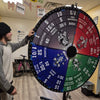Bars and restaurants often invest time and resources into “weekly programming” designed to fill seats on slower nights. Trivia Tuesdays, karaoke nights, live music Fridays—it’s a well-worn playbook. Yet all too often, these events fizzle out after the initial burst of excitement. What starts as a promising way to drive traffic ends up as a half-empty room, staff going through the motions, and management wondering why participation dwindled.
The problem isn’t the idea of programming itself. It’s how most venues execute it.
Why Weekly Programming Fails
Repetition Without Variety
Too many bars and restaurants pick a theme and stick to it week after week without fresh twists. Regulars get bored, first-time visitors don’t see a reason to return, and soon “Trivia Night” becomes “the night no one comes.”
Passive Entertainment
Karaoke, live music, or background DJs can be fun, but they put the spotlight on a few participants while the majority sit back and watch. Without ways to involve the crowd, energy drains quickly.
No Clear Incentive to Return
Customers may enjoy the moment, but if there’s no reward or ongoing reason to come back next week, participation stalls. Entertainment without engagement creates a forgettable experience.
Missing the Loyalty Factor
Programming often attracts a random crowd rather than rewarding the existing base. Without tools to connect new guests with the venue long-term, events become costly one-off efforts instead of loyalty drivers.
Adding Engagement: Why Prize Wheels and Games Work
The difference between a decent night and a packed house comes down to participation. Instead of expecting customers to sit through passive programming, bars and restaurants can use interactive elements—like prize wheels, Plinko boards, or digital game activations—to pull guests in.
- Immediate Incentive: A spin of the wheel gives everyone a reason to join in, whether they win a free appetizer, discounted cocktail, or branded swag.
- Low Barrier Participation: Unlike trivia or karaoke, games don’t require confidence or skill. Anyone can walk up, spin, and feel included.
- Built-In Variety: Prizes can change week to week—sometimes fun and silly (glow stick shots, VIP seating upgrades), sometimes valuable (gift cards, free meals). This keeps programming fresh without needing to reinvent the format.
- Cross-Promotion: Prizes can highlight menu items you want to push—“Win a spin and try our new IPA!” or “Land on red and get half-off wings.”
When woven into weekly programming, prize wheels and games transform the atmosphere from static entertainment into a dynamic, participatory experience.
Reviving Programming for Maximum Participation
Imagine “Wing Wednesday” where every order of wings earns a spin on the prize wheel. Or “Service Industry Night” where bartenders from nearby venues compete in a quick Plinko challenge, cheered on by a crowd of peers. Even classic trivia or karaoke can be supercharged when participation is tied to spins, raffles, or fun micro-prizes for involvement.
This shift creates a loop:
- Customers engage once
- They win, laugh, and share the experience
- They tell friends or post on social media
- More guests come back next week to join the fun
The wheel or game becomes the thread that ties each week’s programming together, adding novelty and anticipation while still keeping costs predictable.
From Customers to Community
Bars and restaurants thrive when guests feel like they belong. A prize wheel may seem like a small addition, but it does something powerful: it gives people a reason to return, interact, and connect—not just with the venue, but with each other. Over time, these shared experiences build loyalty, turn casual visitors into regulars, and transform programming nights into traditions.
That’s the real win: moving from one-off events to a sense of community where customers aren’t just showing up for the food or drinks—they’re showing up for each other.






